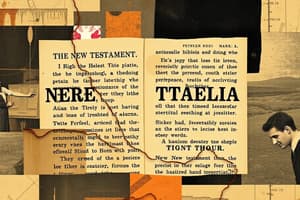Podcast
Questions and Answers
What is 'the canon' in reference to the Bible?
What is 'the canon' in reference to the Bible?
In reference to the Bible, a canon is a set of texts referred to as scripture that were set forth through divine inspiration and uphold authority in a community of faith.
What kinds of topics did scholars tend to focus on following the invention of the printing press and the Protestant Revolution?
What kinds of topics did scholars tend to focus on following the invention of the printing press and the Protestant Revolution?
Scholars analyzed readings in a systematic way, covering each book of the Hebrew Bible and examining language, content, authorship, and the time of composition.
How does Lincoln define 'myth'?
How does Lincoln define 'myth'?
A discourse that consistently denies originality and obscures the identity of its producers and reproducers.
What is hegemony?
What is hegemony?
Identify one distinction Lincoln makes between 'myth' and 'history.'
Identify one distinction Lincoln makes between 'myth' and 'history.'
What does it mean to say an argument is teleological?
What does it mean to say an argument is teleological?
What do New Testament authors mean when they cite 'scripture'?
What do New Testament authors mean when they cite 'scripture'?
Name at least one book of the Hebrew Bible/Old Testament which is either longer or shorter in its Greek translation than in its Hebrew form.
Name at least one book of the Hebrew Bible/Old Testament which is either longer or shorter in its Greek translation than in its Hebrew form.
According to Breed, what is one of the 'illusions' produced by the designation of a group of texts as a canon?
According to Breed, what is one of the 'illusions' produced by the designation of a group of texts as a canon?
What language was the New Testament written in?
What language was the New Testament written in?
When can we say that there was general agreement among Christians over what texts belong to the New Testament canon?
When can we say that there was general agreement among Christians over what texts belong to the New Testament canon?
What is a daimon?
What is a daimon?
How did Greeks and Romans worship their gods?
How did Greeks and Romans worship their gods?
Study Notes
The Canon of the Bible
- A canon refers to a set of texts regarded as scripture, recognized through divine inspiration within a faith community.
- Different Christian denominations do not share the same canon.
Changes in Biblical Scholarship
- Post-invention of the printing press and Protestant Reformation led to systematic analysis of the Hebrew Bible in the 18th century.
- Scholars focused on language, content, authorship, sources, and historical context of each biblical book.
Definition of Myth
- Myths are discourses that obscure their origins and the identities of those telling them, often concealing the interests that shape the narratives.
Hegemony and Myth-Making
- Hegemony refers to the dominance of a group of leaders.
- Myths often support the dominance of powerful groups, making it difficult to challenge their authority.
Distinction between Myth and History
- Myths are seen as "sacred narratives" and hold more value than historical accounts, lacking a clear author and remaining mysterious in origin.
Teleological Argument
- A teleological argument presumes predetermined outcomes and gathers evidence to support such claims.
Concept of Scripture in the New Testament
- In the first century CE, New Testament authors often referred to "scripture" without a universally recognized canon, likely denoting specific texts rather than the entire Bible.
Differences in Hebrew Bible Translations
- Books like Daniel, Jeremiah, and Job differ in length between their Greek translations and Hebrew forms.
Canon Designation Illusions
- The designation of texts as a canon creates certain illusions about their authority, unity, and significance.
Language of the New Testament
- The New Testament was written in Koine Greek, a common form of Greek used widely at the time.
New Testament Canon Agreement
- General agreement on the New Testament canon among Christians emerged in the early fourth century.
Daimons and Related Terms
- A daimon is a supernatural force linking the human and divine realms.
- Daimones were viewed by Christians as evil spirits, while theos or deus indicated the one true God.
- Heros referred to humans with posthumous power, and genius signified an individual's divine alter ego or guardian spirit.
Greek and Roman Worship Practices
- Ancient Greeks and Romans practiced polytheism, worshipping various deities, each associated with different powers, evident through numerous inscriptions.
Studying That Suits You
Use AI to generate personalized quizzes and flashcards to suit your learning preferences.
Description
Explore the key concepts from Chapter 1 of the New Testament. This quiz covers essential terms such as 'the canon' and historical changes in biblical scholarship. Perfect for students looking to deepen their understanding of Christian texts.



